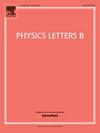Approaching 100Sn: Structural evolution in 98,100Cd via lifetime measurements
IF 4.5
2区 物理与天体物理
Q1 ASTRONOMY & ASTROPHYSICS
引用次数: 0
Abstract
The lifetimes of low-lying excited states below the seniority isomer were directly measured using fast timing detectors in the neutron-deficient isotopes 98,100Cd. This experiment was conducted with the DEcay SPECtroscopy (DESPEC) setup at GSI, where the ions of interest were produced via a fragmentation reaction and identified using the FRagment Separator (FRS) before being implanted in the AIDA active stopper system, and the γ rays emitted during the de-excitation of isomeric states were detected by the LaBr3 FATIMA Array. The newly deduced values for the reduced transition probabilities were compared with shell-model calculations using different interactions and effective charges. The results indicate that, while 98Cd aligns well with a seniority scheme description, in 100Cd the transition strengths among low-lying states are not fully reproduced, and the nature of these states remains an open problem within the present theoretical description. Ultimately, a key element in the description of this region, crucial for nuclear physics and astrophysics, appears to be the proton-neutron term of the nuclear effective interaction.
接近100Sn:通过寿命测量98,100Cd的结构演化
利用快速定时探测器直接测量了缺中子同位素98,100Cd中低于8+资历异构体的低空激发态寿命。本实验采用GSI的衰变光谱(DESPEC)装置进行,其中感兴趣的离子通过破碎反应产生,并在植入AIDA主动阻挡系统之前使用碎片分离器(FRS)进行鉴定,并通过LaBr3 FATIMA阵列检测异构体状态去激发过程中发射的γ射线。利用不同的相互作用和有效电荷,将新推导的简化跃迁概率值与壳模型计算值进行了比较。结果表明,虽然98Cd与资历方案描述很好地吻合,但在100Cd中,低洼状态之间的过渡强度并没有完全再现,这些状态的性质在目前的理论描述中仍然是一个开放的问题。最后,描述这一区域的一个关键因素,对核物理学和天体物理学至关重要,似乎是核有效相互作用的质子-中子项。
本文章由计算机程序翻译,如有差异,请以英文原文为准。
求助全文
约1分钟内获得全文
求助全文
来源期刊

Physics Letters B
物理-物理:综合
CiteScore
9.10
自引率
6.80%
发文量
647
审稿时长
3 months
期刊介绍:
Physics Letters B ensures the rapid publication of important new results in particle physics, nuclear physics and cosmology. Specialized editors are responsible for contributions in experimental nuclear physics, theoretical nuclear physics, experimental high-energy physics, theoretical high-energy physics, and astrophysics.
 求助内容:
求助内容: 应助结果提醒方式:
应助结果提醒方式:


